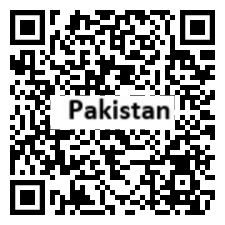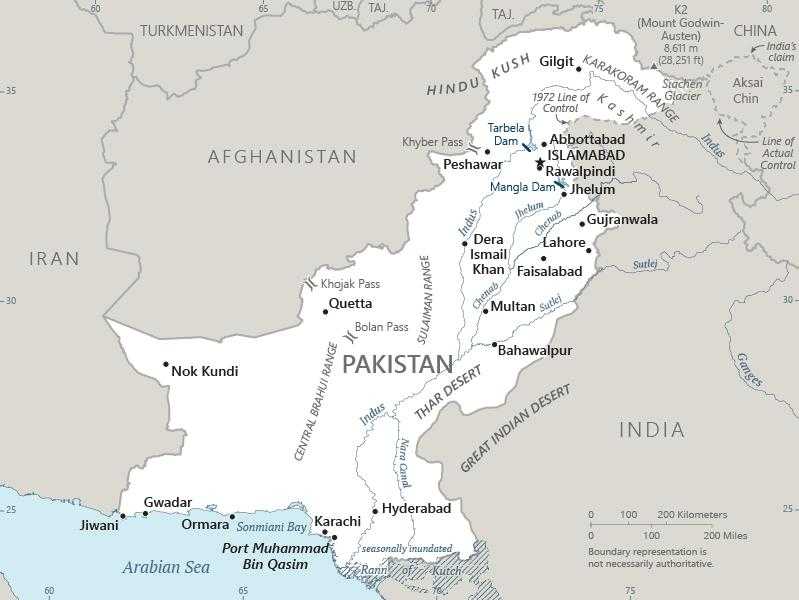Introduction
Background
The Indus Valley civilization, one of the oldest in the world and dating back at least 5,000 years, spread over much of modern-day Pakistan. The British dominated the region in the 18th century. The separation in 1947 of British India into the Muslim state of Pakistan (with West and East sections) and largely Hindu India was never satisfactorily resolved, and the countries continue to spar over the Kashmir territory.
Geography
Area
total: 796,095 sq km
land: 770,875 sq km
water: 25,220 sq km
Climate
mostly hot, dry desert; temperate in northwest; arctic in north
Natural resources
arable land, extensive natural gas reserves, limited petroleum, poor quality coal, iron ore, copper, salt, limestone
People and Society
Population
total: 252,363,571
male: 128,387,797
female: 123,975,774 (2024 est.)
Ethnic groups
Punjabi 44.7%, Pashtun (Pathan) 15.4%, Sindhi 14.1%, Saraiki 8.4%, Muhajirs 7.6%, Baloch 3.6%, other 6.3%
Languages
Punjabi 38.8%, Pashto (alternate name, Pashtu) 18.2%, Sindhi 14.6%, Saraiki (a Punjabi variant) 12.2%, Urdu 7.1%, Balochi 3%, Hindko 2.4%, Brahui 1.2%, other 2.4%
Religions
Muslim (official) 96.5% (Sunni 85-90%, Shia 10-15%), other (includes Christian and Hindu) 3.5% (2020 est.)
Population growth rate
1.86% (2024 est.)
Government
Government type
federal parliamentary republic
Capital
name: Islamabad
Executive branch
chief of state: President Asif Ali ZARDARI (since 10 March 2024)
head of government: Caretaker Prime Minister Shahbaz SHARIF (since 3 March 2024)
Legislative branch
description: bicameral Parliament or Majlis-e-Shoora consists of:
Senate (104 seats current, reduced by 4 seats at the 2024 election and 4 at the 2027 election; members indirectly elected by the 4 provincial assemblies and the federal capital territory indirectly elected by the National Assembly using proportional representation vote; members serve 6-year terms with one-half of the membership renewed every 3 years)
National Assembly (342 seats; 272 members directly elected in single-seat constituencies by simple majority vote and 70 members - 60 women and 10 non-Muslims - directly elected by proportional representation vote; all members serve 5-year terms)
Economy
Economic overview
lower middle-income South Asian economy; extremely high debt; endemic corruption; major currency devaluation; major food insecurity and inflation; environmentally fragile agricultural sector; regional disputes with India and Afghanistan hinder investment
Real GDP (purchasing power parity)
$1.268 trillion (2022 est.)
$1.211 trillion (2021 est.)
$1.137 trillion (2020 est.)
Real GDP per capita
$5,400 (2022 est.)
$5,200 (2021 est.)
$5,000 (2020 est.)
Agricultural products
sugarcane, bison milk, wheat, milk, rice, maize, potatoes, mangoes/guavas, cotton, onions (2022)
Industries
textiles and apparel, food processing, pharmaceuticals, surgical instruments, construction materials, paper products, fertilizer, shrimp
Exports
$38.968 billion (2022 est.)
$35.612 billion (2021 est.)
$27.333 billion (2020 est.)
Exports - partners
US 17%, Germany 7%, China 7%, UAE 7%, UK 6% (2022)
Exports - commodities
garments, fabric, cotton fabric, rice, refined petroleum (2022)
Imports
$76.426 billion (2022 est.)
$76.514 billion (2021 est.)
$52.098 billion (2020 est.)
Imports - partners
China 28%, UAE 8%, Indonesia 6%, Saudi Arabia 6%, Kuwait 5% (2022)
Imports - commodities
refined petroleum, crude petroleum, natural gas, palm oil, cotton (2022)
Exchange rates
Pakistani rupees (PKR) per US dollar -
Exchange rates:
204.867 (2022 est.)
162.906 (2021 est.)
161.838 (2020 est.)
150.036 (2019 est.)
121.824 (2018 est.)
Page last updated: Wednesday, May 15, 2024




